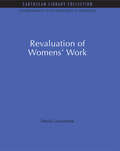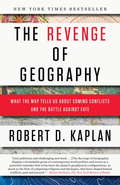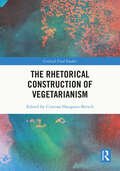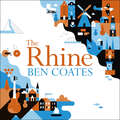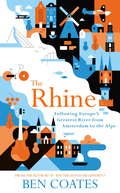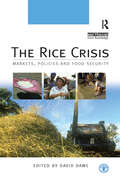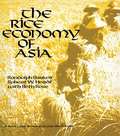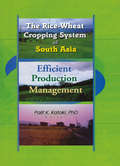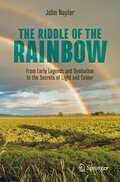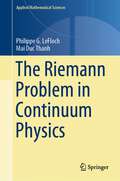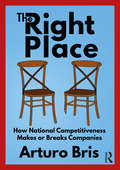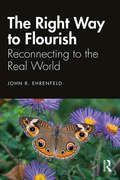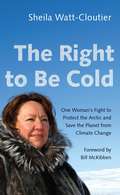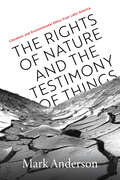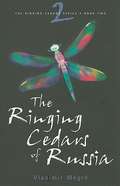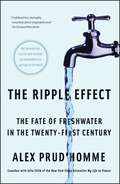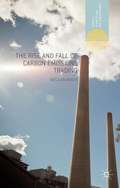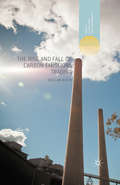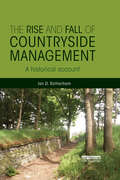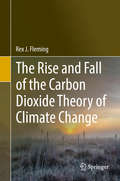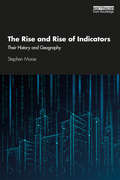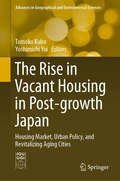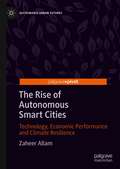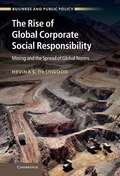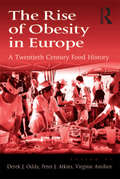- Table View
- List View
The Revaluation of Women's Work (Environmental and Resource Economics Set)
by Sheila LewenhakThis book provides a survey and analysis of the different ways in which women's work is valued throughout the world. It challenges the narrow definition of work as paid work, as that excludes so many of women's activities. It looks at ways in which women's worth has been consistently undervalued in industrial as well as non-industrial countries, in socialist as well as free-enterprise economies. These practices distort the national product of countries heavily dependent on women's labour, but, above all, they are among the most obvious marks of the exploitation of women. Technological changes are already altering established female/male divisions of labour. Transnational enterprises, often located in Special Economic Zones, are reducing differences between industrial and nonindustrial countries. Valuing women's work correctly, whether unpaid in the home or underpaid outside it, is part of the battle against discrimination and poverty. Men who do similar work also benefit. It is the crucial step towards the achievement of male/female equality. The book will be particularly valuable for those concerned with the issues, in trade unions, women's groups, international agencies and NGOs and for course in economics and social studies.
The Revenge of Geography: What the Map Tells Us About Coming Conflicts and the Battle Against Fate
by Robert D. KaplanIn this provocative, startling book, Robert D. Kaplan, the bestselling author of Monsoon and Balkan Ghosts, offers a revelatory new prism through which to view global upheavals and to understand what lies ahead for continents and countries around the world. In The Revenge of Geography, Kaplan builds on the insights, discoveries, and theories of great geographers and geopolitical thinkers of the near and distant past to look back at critical pivots in history and then to look forward at the evolving global scene. Kaplan traces the history of the world's hot spots by examining their climates, topographies, and proximities to other embattled lands. The Russian steppe's pitiless climate and limited vegetation bred hard and cruel men bent on destruction, for example, while Nazi geopoliticians distorted geopolitics entirely, calculating that space on the globe used by the British Empire and the Soviet Union could be swallowed by a greater German homeland. Kaplan then applies the lessons learned to the present crises in Europe, Russia, China, the Indian subcontinent, Turkey, Iran, and the Arab Middle East. The result is a holistic interpretation of the next cycle of conflict throughout Eurasia. Remarkably, the future can be understood in the context of temperature, land allotment, and other physical certainties: China, able to feed only 23 percent of its people from land that is only 7 percent arable, has sought energy, minerals, and metals from such brutal regimes as Burma, Iran, and Zimbabwe, putting it in moral conflict with the United States. Afghanistan's porous borders will keep it the principal invasion route into India, and a vital rear base for Pakistan, India's main enemy. Iran will exploit the advantage of being the only country that straddles both energy-producing areas of the Persian Gulf and the Caspian Sea. Finally, Kaplan posits that the United States might rue engaging in far-flung conflicts with Iraq and Afghanistan rather than tending to its direct neighbor Mexico, which is on the verge of becoming a semifailed state due to drug cartel carnage. A brilliant rebuttal to thinkers who suggest that globalism will trump geography, this indispensable work shows how timeless truths and natural facts can help prevent this century's looming cataclysms.Advance praise for The Revenge of Geography "Robert D. Kaplan wields geography like a scalpel, using it to examine international relations and conflicts that globalization fails to explain. The Revenge of Geography is a sagacious account of how geography has shaped the world we know--and what this means for the future. Kaplan's wedding of historical and present-day analysis on a region-by-region basis makes for a well-researched, entertaining, and informative read that cannot be ignored."--Ian Bremmer, president of Eurasia Group and author of Every Nation for Itself "The importance of geography in shaping history is the great issue that Robert Kaplan tackles in this extraordinary book. Thirty years of scholarship and travel lie behind his recounting of human triumphs and conflicts through the ages. At the heart of his wide-ranging analysis is his belief in the abiding influence of geography on human behavior, now and in the future."--James Hoge, counselor, Council on Foreign RelationsFrom the Hardcover edition.
The Rhetorical Construction of Vegetarianism (Critical Food Studies)
by Cristina Hanganu-BreschThis book explores themes in the rhetoric of vegetarian discourse. A vegan practice may help mitigate crises such as climate change, global health challenges, and sharpening socioeconomic disparities, by ensuring both fairness in the treatment of animals and food justice for marginalized populations. How the message is spread is crucial for these aims. Vegan practices thus uncover tensions between individual dietary choices and social justice activism, between ego and eco, between human and animal, between capitalism and environmentalism, and within the larger universe of theoretical and practical ethics. The chapters apply rhetorical methodologies to understand vegan/vegetarian discourse, emphasizing, for example, vegan/vegetarian rhetoric through the lens of polyphony, the role of intersectional rhetoric in becoming vegan, as well as ecofeminist, semiotic, and discourse theory approaches to veganism. The book aims to show that a rhetorical understanding of vegetarian and vegan discourse is crucial for the goals of movements promoting veganism. The book is intended for a wide interdisciplinary audience of scholars, researchers, and individuals interested in veganism, food and media studies, rhetorical studies, human-animal studies, cultural studies and related disciplines. It urges readers to examine vegan discourses seriously, not just as a matter of personal choice or taste but as one vital for intersectional justice and our planetary survival.
The Rhine: Following Europe's Greatest River from Amsterdam to the Alps
by Ben Coates*SHORTLISTED FOR THE STANFORD DOLMAN TRAVEL BOOK OF THE YEAR AWARD*Ben Coates, author of Why the Dutch are Different, cycles the Rhine river from mouth to source, discovering the mark it makes on Europe.The Rhine is one of the world's greatest rivers. Once forming the outer frontier of the Roman Empire, it flows 800 miles from the social democratic playground of the Netherlands, through the industrial and political powerhouses of Germany and France, to the wealthy mountain fortresses of Switzerland and Liechtenstein. For five years, Ben Coates lived alongside a major channel of the river in Rotterdam, crossing it daily, swimming and sailing in its tributaries. In The Rhine, he sets out by bicycle from the Netherlands where it enters the North Sea, following it through Germany, France and Liechtenstein, to its source in the icy Alps. He explores the impact that the Rhine has had on European culture and history and finds out how influences have flowed along and across the river, shaping the people who live alongside it. Blending travelogue and offbeat history, The Rhine tells the fascinating story of how a great river helped shape a continent.(P) 2021 Hodder & Stoughton Limited
The Rhine: Following Europe’s Greatest River from Amsterdam to the Alps
by Ben CoatesThe Rhine is one of the world's greatest rivers. Once forming the outer frontier of the Roman Empire, it flows 800 miles from the social democratic playground of the Netherlands, through the industrial and political powerhouses of Germany and France, to the wealthy mountain fortresses of Switzerland and Liechtenstein. For five years, Ben Coates lived alongside a major channel of the river in Rotterdam, crossing it daily, swimming and sailing in its tributaries. In The Rhine, he sets out by bicycle from the Netherlands where it enters the North Sea, following it through Germany, France and Liechtenstein, to its source in the icy Alps. He explores the impact that the Rhine has had on European culture and history and finds out how influences have flowed along and across the river, shaping the people who live alongside it. Blending travelogue and offbeat history, The Rhine tells the fascinating story of how a great river helped shape a continent.
The Rice Crisis: Markets, Policies and Food Security
by David DaweThe recent escalation of world food prices – particularly for cereals - prompted mass public indignation and demonstrations in many countries, from the price of tortilla flour in Mexico to that of rice in the Philippines and pasta in Italy. The crisis has important implications for future government trade and food security policies, as countries re-evaluate their reliance on potentially more volatile world markets to augment domestic supplies of staple foods. This book examines how government policies caused and responded to soaring world prices in the particular case of rice, which is the world's most important source of calories for the poor. Comparable case studies of policy reactions in different countries, principally across Asia, but also including the USA, provide the understanding necessary to evaluate the impact of trade policy on the food security of poor farmers and consumers. They also provide important insights into the concerns of developing countries that are relevant for future international trade negotiations in key agricultural commodities. As a result, more appropriate policies can be put in place to ensure more stable food supplies in the future. Published with the Food and Agriculture (FAO) Organization of the United Nations
The Rice Economy of Asia
by Randolph Barker Robert W. Herdt Beth RoseTo millions of people in the world, rice is the center of existence, especially in Asia, where more than 90 percent of the world's rice is grown. This book is about the trends and changes that have occurred in the Asian rice economy since World War II, but particularly since the introduction of new varieties of rice and modern technology in the mid-1960s. Although there is now a vast amount of literature and statistical data on various aspects of the subject, no single comprehensive treatment has previously been prepared. The Rice Economy of Asia not only provides such a treatment but also presents a clear picture of some of the critical issues dealing with productivity and equity --- as a glance at the table of contents will show. In addition to 18 chapters, there are an extensive bibilography, 150 tables, and 50 charts. The volume, as a whole, should be interesting and useful to decisionmakers at national and international levels, to professionals, and to students of development.
The Rice-Wheat Cropping System of South Asia: Efficient Production Management
by Suresh Chandra Babu Palit KatakiThe lives of more than a billion people depend on the answer!This valuable book surveys the problems of the rice-wheat cropping system practiced on the Indo-Gangetic Plain (IGP). Introduced at the time of the Green Revolution, it transformed agriculture and produced thirty years of bumper crops. The Rice-Wheat Cropping System of South Asia: Efficient Production Management offers scientific analysis of the aftereffects of this intense cropping. The Rice-Wheat Cropping System of South Asia: Efficient Production Management focuses on the questions of soil depletion, pest infestation, and soil alkalinity as elements of declining productivity. Along with clear charts, maps, and graphs, it provides practical suggestions for improving and maintaining the productivity of this irreplaceable farmland. The Rice-Wheat Cropping System of South Asia looks at the problems that have arisen for both the rice and wheat phases, including: depletion of micronutrients degradation of major nutrients from unbalanced fertilization practices infestations of nematodes increasing soil alkalinity as a result of irrigationIt also suggests solutions for maintaining productivity, including: integrated pest management sustainable agriculture micronutrient fertilizersThis informative book and its companion volume, The Rice-Wheat Cropping System of South Asia: Trends, Constraints, Productivity and Policy, are essential planning tools for agronomists, policymakers, and agroeconomists. It is also a useful reference for anyone interested in the problems of famine and intensive cropping not only in South Asia but in the world.
The Riddle of the Rainbow: From Early Legends and Symbolism to the Secrets of Light and Colour (Copernicus Books)
by John NaylorRainbows have been a source of fascination since time immemorial. They have been the subject of myth and superstition, an inspiration to poets, a challenge to painters, the object of intense scientific interest and a touchstone for ideas about the nature of light and colour. Above all, the rainbow has been the embodiment of wonder from the earliest times to the present day.Beginning with the circumstances in which you are likely to see a rainbow and descriptions of its salient features, this book recounts and explains the myths and superstitions about rainbows, and describes how poets, painters and, above all, leading scientists in every age have sought to discover and understand the rainbow’s secrets.Readers with a love of nature and art and an interest in the history of science will enjoy this attractive and informative book.
The Riemann Problem in Continuum Physics (Applied Mathematical Sciences #219)
by Philippe G. LeFloch Mai Duc ThanhThis monograph provides a comprehensive study of the Riemann problem for systems of conservation laws arising in continuum physics. It presents the state-of-the-art on the dynamics of compressible fluids and mixtures that undergo phase changes, while remaining accessible to applied mathematicians and engineers interested in shock waves, phase boundary propagation, and nozzle flows. A large selection of nonlinear hyperbolic systems is treated here, including the Saint-Venant, van der Waals, and Baer-Nunziato models. A central theme is the role of the kinetic relation for the selection of under-compressible interfaces in complex fluid flows. This book is recommended to graduate students and researchers who seek new mathematical perspectives on shock waves and phase dynamics.
The Right Place: How National Competitiveness Makes or Breaks Companies
by Arturo BrisThe Right Place explains why firms succeed in one country and fail in another, irrespective of their inner drivers, and suggests potential initiatives that governments can take to help the private sector create jobs and, consequently, make their countries more prosperous. The competitiveness race is not unlike a cycling race. If you want to ride fast, you need three things: a good bike, to be in good shape, and a smooth and fast road. In a collaborative model, you might say the business is the bicycle, the business leader is the cyclist, and the road is the government and the external environment. The responsibility of a government is to design and build the best possible road. It turns out that when the road is good, good cyclists suddenly appear and want to race on it. In this book, competition and macroeconomics expert, Arturo Bris, provides the analysis of country competitive performance based on 30 years advising countries on this topic. The typical mistakes that countries make are revealed and the pillars necessary in building a competitive economy: economic performance as a necessary condition for prosperity; government efficiency, so the public sector can create the conditions for a productive economy; business efficiency, so companies can create jobs; and infrastructure, both tangible and intangible, so businesses and individuals can operate efficiently. With contemporary case studies throughout, the book provides an illuminating read for politicians, business leaders and students of macroeconomics.
The Right Way to Flourish: Reconnecting to the Real World
by John EhrenfeldIn this ground-breaking book, pre-eminent thought leader in the fields of sustainability and flourishing, John R. Ehrenfeld, critiques the concept of sustainability as it is understood today and which is coming more and more under attack as unclear and ineffective as a call for action. Building upon the recent work of cognitive scientist, Iain McGilchrist, who argues that the human brain’s two hemispheres present distinct different worlds, this book articulates how society must replace the current foundational left-brain-based beliefs – a mechanistic world and a human driven by self interest – with new ones based on complexity and care. Flourishing should replace the lifeless metrics now being used to guide business and government, as well as individuals. Until we accept that our modern belief structure is, itself, the barrier, we will continue to be mired in an endless succession of unsolved problems.
The Right to Be Cold: One Woman's Fight to Protect the Arctic and Save the Planet from Climate Change
by Sheila Watt-CloutierA &“courageous and revelatory memoir&” (Naomi Klein) chronicling the life of the leading Indigenous climate change, cultural, and human rights advocate For the first ten years of her life, Sheila Watt-Cloutier traveled only by dog team. Today there are more snow machines than dogs in her native Nunavik, a region that is part of the homeland of the Inuit in Canada. In Inuktitut, the language of Inuit, the elders say that the weather is Uggianaqtuq—behaving in strange and unexpected ways. The Right to Be Cold is Watt-Cloutier&’s memoir of growing up in the Arctic reaches of Quebec during these unsettling times. It is the story of an Inuk woman finding her place in the world, only to find her native land giving way to the inexorable warming of the planet. She decides to take a stand against its destruction.The Right to Be Cold is the human story of life on the front lines of climate change, told by a woman who rose from humble beginnings to become one of the most influential Indigenous environmental, cultural, and human rights advocates in the world. Raised by a single mother and grandmother in the small community of Kuujjuaq, Quebec, Watt-Cloutier describes life in the traditional ice-based hunting culture of an Inuit community and reveals how Indigenous life, human rights, and the threat of climate change are inextricably linked. Colonialism intervened in this world and in her life in often violent ways, and she traces her path from Nunavik to Nova Scotia (where she was sent at the age of ten to live with a family that was not her own); to a residential school in Churchill, Manitoba; and back to her hometown to work as an interpreter and student counselor. The Right to Be Cold is at once the intimate coming-of-age story of a remarkable woman, a deeply informed look at the life and culture of an Indigenous community reeling from a colonial history and now threatened by climate change, and a stirring account of an activist&’s powerful efforts to safeguard Inuit culture, the Arctic, and the planet.
The Rights of Nature and the Testimony of Things: Literature and Environmental Ethics from Latin America
by Mark AndersonThe Rights of Nature and the Testimony of Things begins by analyzing the ethical debates and political contexts relating to Latin American &“rights of nature&” legislation and the political ontology of nonhuman speech within a framework of intercultural and multispecies diplomacy. Author Mark Anderson shows how Latin American authors and thinkers complicate traditional humanistic perspectives on nature, the social, and politics, exploring how animals, plants, and environments as a whole might be said to engage in social relations and political speech or self-representation. Drawing Native Amazonian thought into productive tension with a variety of posthumanist theoretical frameworks—ranging from Derrida&’s conceptualization of passive decision and hospitality to biosemiotics, Karen Barad&’s theorization of intra-activity, and Isabelle Stengers&’ proposal for cosmopolitical diplomacy—Anderson analyzes literary works by Julio Cortázar, Clarice Lispector, José Eustasio Rivera, and Davi Kopenawa that reframe environmental ethics in terms of collective, multispecies work and reciprocal care and politics as a cosmopolitics of friendship rooted in diplomacy across difference. Finally, Anderson examines the points of connection and divergences between Latin American relational ontologies and Euro American posthumanist theories within Indigenous Latin American remodernization projects that reappropriate and repurpose ancestral practices as well as develop new technologies with the goal of forging alternative modernities compatible with a livable future for all species.
The Ringing Cedars of Russia (The Ringing Cedars Series #2)
by Vladimir Megré John Woodsworth Leonid SharashkinAfter rising rapidly to the top of national best-seller lists, first-time author Vladimir Megre has some explaining to do.
The Ripple Effect
by Alex Prud'HommeNow in paperback from the bestselling coauthor with Julia Child of My Life in France "a balanced and insightful assessment of what could emerge as the dominant issue in decades ahead" (Associated Press)--the fate of fresh water in the twenty-first century.With The Ripple Effect, Alex Prud'homme has changed the way we think about the water we drink. Inspired by an interest in our worldwide obsession with bottled water, Prud'homme undertook an ambitious quest to understand the evolving story of freshwater. What he found was shocking: as the climate warms and world population grows, demand for water has surged, but supplies of fresh water are static or dropping, and new threats to water quality appear every day. The questions he sought to answer were urgent: Will there be enough water to satisfy demand? What are the threats to its quality? What is the state of our water infrastructure--both the pipes that bring us fresh water and the levees that keep it out? How secure is our water supply from natural disasters and terrorist attacks? Can we create new sources for our water supply through scientific innovation? Is water a right like air or a commodity like oil--and who should control the tap? Like Daniel Yergin's seminal classic The Prize: The Epic Quest for Oil, Money, & Power, The Ripple Effect is a masterwork of investigation and a dramatic narrative, spanning from the alleged murder of a water scientist in New Jersey to the epic confrontation between salmon fishermen and copper miners in Alaska. The Ripple Effect is a major achievement and will change our understanding of the importance of water forever. el Pollan has changed the way we think about the food we eat; Alex Prud'homme will change the way we think about the water we drink. Informative and provocative, The Ripple Effect is a major achievement.
The Rise and Fall of Carbon Emissions Trading (Energy, Climate and the Environment)
by Declan KuchThe Rise and Fall of Carbon Emissions Trading.
The Rise and Fall of Carbon Emissions Trading (Energy, Climate and the Environment)
by Declan KuchThis book presents the results of the first full-scale emissions trading schemes in Australia and internationally, arguing these schemes will not be sufficient to 'civilize markets' and prevent dangerous climate change. Instead, it articulates the ways climate policy needs to confront the collective nature of our predicament.
The Rise and Fall of Countryside Management: A Historical Account
by Ian D. RotherhamFor at least half a century since the emergence of Country Parks and Forest Parks, countryside services have provided leisure, tourism, conservation, restoration and regeneration across Britain. Yet these services are currently being decimated as public services are sacrificed to the new era of austerity. The role and importance of countryside management have been barely documented, and the consequences and ramifications of cuts to these services are overlooked and misunderstood. This volume rigorously examines the issues surrounding countryside management in Britain. The author brings together the results of stakeholder workshops and interviews, and in-depth individual case studies, as well as a major study for the Countryside Agency which assessed and evaluated every countryside service provision in England. A full and extensive literature review traces the ideas of countryside management back to their origins, and the author considers the wider relationships and ramifications with countryside and ranger provisions around the world, including North America and Europe. The book provides a critical overview of the history and importance of countryside management, detailing the achievements of a largely forgotten sector and highlighting its pivotal yet often underappreciated role in the wellbeing of people and communities. It serves as a challenge to students, planners, politicians, conservationists, environmentalists, and land managers, in a diversity of disciplines that work with or have interests in countryside, leisure and tourism, community issues, education, and nature conservation.
The Rise and Fall of the Carbon Dioxide Theory of Climate Change
by Rex J. FlemingThis book provides a complete review of the role of CO2 in the Earth’s atmosphere and reveals detailed information about the subject of climate change. Many different science disciplines are visited and discussed and each area is introduced with a brief summary written to appeal to a broader audience. The logic of CO2 involvement in changing the climate is investigated from every perspective: reviewing the historical data record of Ice Ages with vast ice sheets, noting the interglacial periods of little or no ice, examining in further detail the 20th century data record and evaluating the radiation role of CO2 in the atmosphere. The radiation calculations, using the appropriate equations and data are reviewed in great detail. The results of this review and examination reveal no role of CO2 in any change of the Earth’s climate. Disclaimer: The views expressed in this book belong solely to the author.
The Rise and Rise of Indicators: Their History and Geography
by Stephen MorseThis book makes indicators more accessible, in terms of what they are, who created them and how they are used. It examines the subjectivity and human frailty behind these quintessentially ‘hard’ and technical measures of the world. To achieve this goal, The Rise and Rise of Indicators presents the world in terms of a selected set of indicators. The emphasis is upon the origins of the indicators and the motivation behind their creation and evolution. The ideas and assumptions behind the indicators are made transparent to demonstrate how changes to them can dramatically alter the ranking of countries that emerge. They are, after all, human constructs and thus embody human biases. The book concludes by examining the future of indicators and the author sets out some possible trajectories, including the growing emphasis on indicators as important tools in the Sustainable Development Goals that have been set for the world up until 2030. This is a valuable resource for undergraduate and postgraduate students in the areas of economics, sociology, geography, environmental studies, development studies, area studies, business studies, politics and international relations.
The Rise in Vacant Housing in Post-growth Japan: Housing Market, Urban Policy, and Revitalizing Aging Cities (Advances in Geographical and Environmental Sciences)
by Tomoko Kubo Yoshimichi YuiThis book explores how Japanese cities have transformed since the 1950s by describing housing and urban planning policies, urbanization processes, and maps with GIS analysis. It also discusses how housing vacancies have increased in shrinking Japanese cities, with case studies in Tokyo, Kyoto, Hiroshima, and Utsunomiya, and examines public–private partnerships and civil engagement to revitalize cities. Providing examples of how Japanese cities have addressed the issues of aging populations and urban shrinkage, it contributes to better decision-making by politicians, planners, local authorities, NPOs, and local communities in many rapidly urbanizing and potentially aging regions such as Asia.In the era of urban shrinkage, Japanese cities have struggled with aging populations, low fertility, population loss, and a decline in the economic base over decades. In particular, shrinkage in metropolitan suburbs and large cities (e.g., sites of prefectural government with 300 000–400 000 inhabitants) has caused serious social problems owing to the huge aging population and large areas covered. One typical problem that has emerged is an increase in vacancies in now empty and abandoned housing.
The Rise of Autonomous Smart Cities: Technology, Economic Performance and Climate Resilience (Sustainable Urban Futures)
by Zaheer AllamThis book introduces the concept of the ‘autonomous city’- a concept that has been developed from the ‘smart cities’ model that is based on a city’s ability to gather data and taking it one step further. The digital revolution has brought about numerous changes in the urban realm, along with the understanding that technology can aid in increasing the performance and efficiency of urban areas. This technology has given rise to a wealth of data allowing urban leaders to respond better to crisis and craft policies that increase the liveability of urban areas. The ‘autonomous city’ explores the possibility of urban areas evolving from the dimension of data gathering to that of action response – so a city able to collect data and render real time decisions to self-manage a variety of functions based on its interpretation of that data. The book discusses how this could lead to the automation of select urban dimensions for increased efficiency and performance, but also details how such a process would require careful consideration when put into practice. This book will be a valuable resource for scholars and students across Urban Planning, Sustainability and STS, as well as practitioners and policy makers involved in the development of urban life.
The Rise of Global Corporate Social Responsibility
by Hevina S. DashwoodCombining insights from international relations theory with institutional approaches from organization theory and public policy, this book provides a complete explanation for the adoption of Corporate Social Responsibility (CSR), showing how global norms influenced CSR adoption in the mining industry. Global normative developments have clearly had an important influence on major mining companies: by the mid 2000s the majority had adopted sustainable development as a normative frame for their CSR policies and practices. However, there is significant variation between firms in terms of the timing, degree of commitment and the willingness to assume a leadership role in promoting global standards for the mining industry. The author finds that attributes internal to the firm, including the critical role of leadership, and the way in which management responds to the institutional context and operational challenges faced in different countries are important influences on CSR adoption and important factors explaining variation.
The Rise of Obesity in Europe: A Twentieth Century Food History
by Derek J. OddyTwentieth century Europe went through a dramatic transition from low income populations experiencing hunger and nutritionally inadequate diets, to the recent era of over-consumption and growing numbers of overweight and obese people. By examining the trends in food history from case studies across Europe, this book offers a historical context to explain how and why this transition has occurred and what we can learn in order to try and address the vitally important issues arising from obesity in contemporary Europe.
